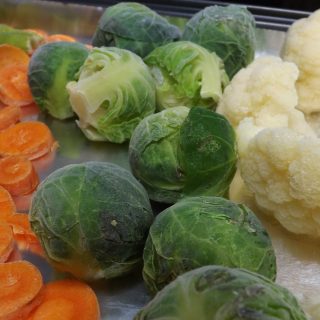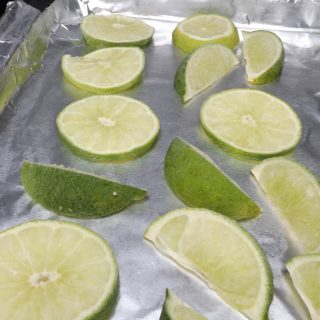There are certain times of year when rhubarb is readily available. So making your favorite rhubarb pie recipe is no problem. However, if you happen to have that pie craving and rhubarb is out of season, you may be out of luck! What if you were able to buy more in bulk when it was plentiful? Wondering if you can freeze rhubarb for later in the year?
Well, not only CAN you freeze rhubarb but we are going to show you exactly HOW to freeze rhubarb! It's super easy, as well, and perfect for making baked good like rhubarb pie.
Now, let's keep on reading so we can learn the best method for freezing rhubarb!
[ez-toc]
Can You Freeze Rhubarb?
Yes, you can freeze rhubarb safely and easily. Frozen rhubarb is just as good as fresh rhubarb. To freeze fresh rhubarb (or cooked rhubarb) you will need to trim off all the leaves and then wash the stalks. Pat them dry with a paper towel and then cut them into ½ inch or smaller pieces. Blanch those pieces, flash freeze, and bag them.
It will keep for 12 months! Rhubarb does not need defrosting and can be added right into a recipe.
The methods used are going to be similar to freezing mashed potatoes, freezing carrots, freezing sweet potatoes, freezing beets, freezing yellow squash, freezing zucchini, freezing okra and many other types of fruits and vegetables. This method of freezing utilizes both blanching and flash freezing.
Freezing Stats
| Blanched | 1 minute (1 lb at a time) |
| Prep Style | Raw Cooked Sliced |
| Time To Freeze | 2 to 4 hours (flash freeze) 12 to 24 (deep freeze) |
| Time to Thaw | a few hours in the fridge add to recipes frozen |
| Uses | Best in baked goods |
| Freezer Life | up to 12 months |
Frozen Vs Non-frozen
| Freezer Life | Fridge Life | Shelf Life |
| up to 1 year | 1 to 3 weeks | 2 to 4 days |
Supplies
You are going to need the following supplies:
- rhubarb
- 2 colanders (1 for washing and 1 for blanching)
- mandolin slicer with protective gloves (for sliced)
- knife and cutting board (if no mandolin slicer)
- large mixing bowl (for blanching ice bath)
- large stock pot (for blanching)
- kitchen timer
- cookie sheet (for flash freezing)
- Freezer bags
- Sharpie or marker
- Freezer
Need to get all your food preserved easily? Check out the Ultimate Guide To Freezing Food so that you can fill your freezer without in minimal time.
How To Freeze Rhubarb
Freezing rhubarb uses both blanching and flash freezing together to get the very best results you can preserving your food.
How To Flash Freeze
Flash freezing just means to start the freezing process on individual pieces of rhubarb for a few hours so that when you pack everything together they do not stick to each other.
This will work the same as it does for many other vegetables that need to be flash frozen, like radishes.
- Wrap a cookie sheet with aluminum foil or lay down a sheet of parchment paper
- Place your rhubarb on the cookie sheet in a single layer without overlapping pieces
- Freeze the entire pan for around 2 to 4 hours
- Label a freezer safe container or freezer bags with the contents, freeze date, and best by date
- Remove the pan from the freezer and move to the next step
Freezing cooked or raw rhubarb
This method works the same for freezing raw rhubarb as well as cooked. The only difference is if it's already cooked, skip to the flash freezing step since you don't need to blanch it.
- Start by removing all of the leaves from the stalk
- Place them in a colander and wash them under cool running water
- You can freeze rhubarb whole or use a mandolin slicer/knife to cut it into slices
- Bring a large stock pot of water to a rolling boil
- Put your rhubarb, 1 lb at a time, into a colander and lower it into the boiling water
- Set a kitchen timer for 1 minute
- While waiting for the timer to go off, prepare an ice bath by filling a large mixing bowl with cold water and ice
- Once the timer goes off, take the colander out of the boiling water and put it into the ice bath
- Set a timer for another minute
- When that timer goes off, remove the colander from the water
- Pat the rhubarb dry with paper towels
- Flash freeze once they are completely dry
- Once flash freezing is finished, add the rhubarb into the labeled containers or freezer bags
- measuring them out with a measuring cup helps later when using for recipes
- Place the bags back into the freezer and leave them undisturbed for the next 24 to 48 hours
Frequently Asked Questions
Q1. Is rhubarb poisonous if frozen?
The leaves are the part of rhubarb that are poisonous, frozen or not. Rhubarb leaves contain a substance called oxalic acid, which is toxic to humans. The frozen rhubarb poison confusion is because when the plant is still growing and the temperature drops to around 25°F or lower, the leaves will actually move that acid into the stalk of the plant, which is the part that we eat.
Fortunately, affected rhubarb plants will show signs of this happening with wilted and dropping leaves and just all around looking like an unhealthy, dying plant. Those plants are skipped during harvest and disposed of.
So, if you heard somewhere that frozen rhubarb is poisonous, don't worry. Unless you are eating it fresh out of a garden with temperatures around 20ºF, you will be just fine.
Q2. Can you freeze rhubarb without cooking or blanching it first?
Freezing any fruits or veggies for long term storage without cooking or blanching them first will end up resulting in poor quality and, in some cases, spoiled food. There is an enzyme that will cause them to continue aging even if they are frozen. The heat from blanching and cooking kills that enzyme so you can freeze worry free.
Q3. Does rhubarb get mushy after freezing?
Unfortunately, most vegetation is going to get mushy after you freeze it. What happens, especially in high moisture foods, is the liquid expands when freezing and causes the cells in the plant to burst on an individual level. When that happens, the entire plant loses it's stability and becomes soggy and mushy.
The nice thing about rhubarb is that, even though it is mushy when you thaw it, you can throw it into just about any recipe without thawing at all!
If you need more help getting your foods frozen, check out the Ultimate Freezing Food Guide for a complete quick start reference so that you can have a well-stocked freezer.


